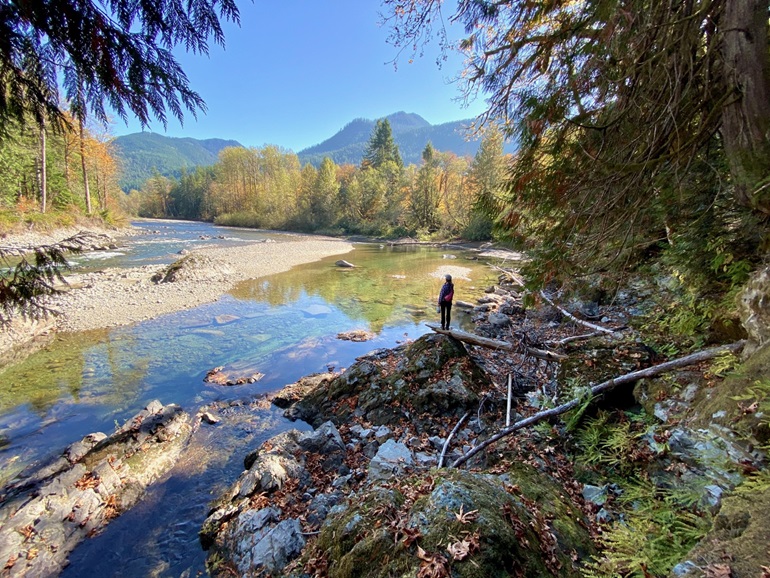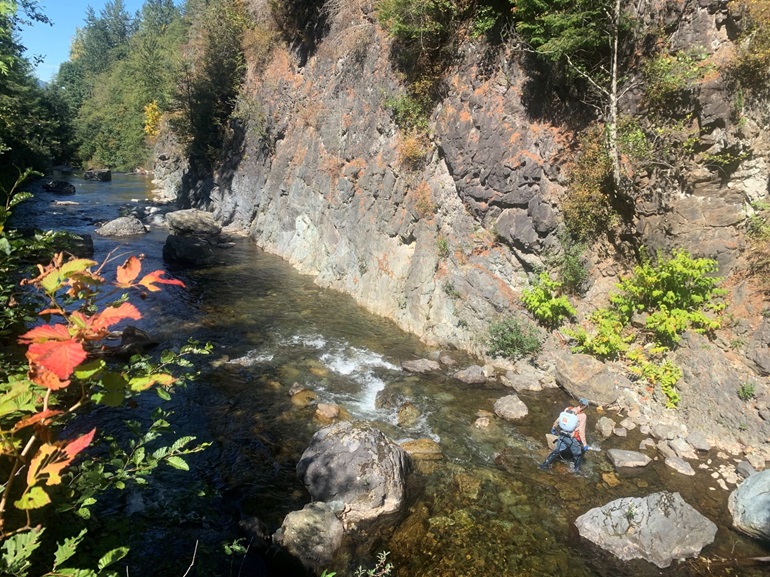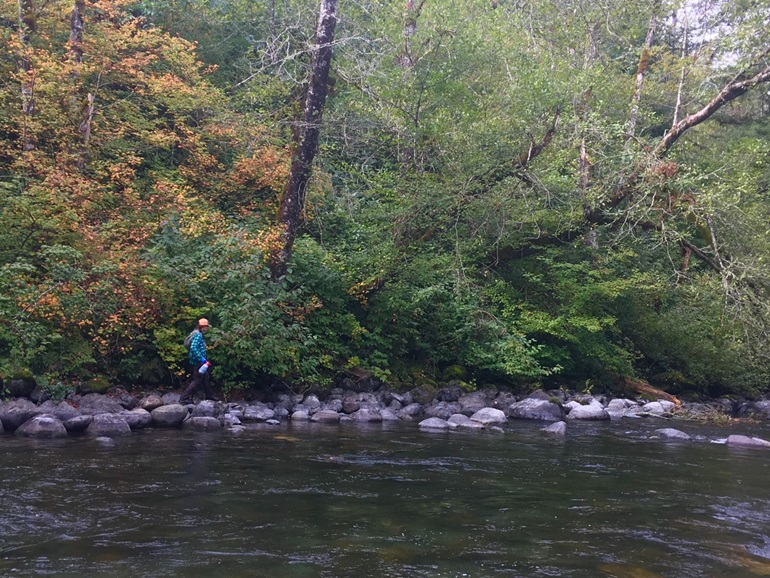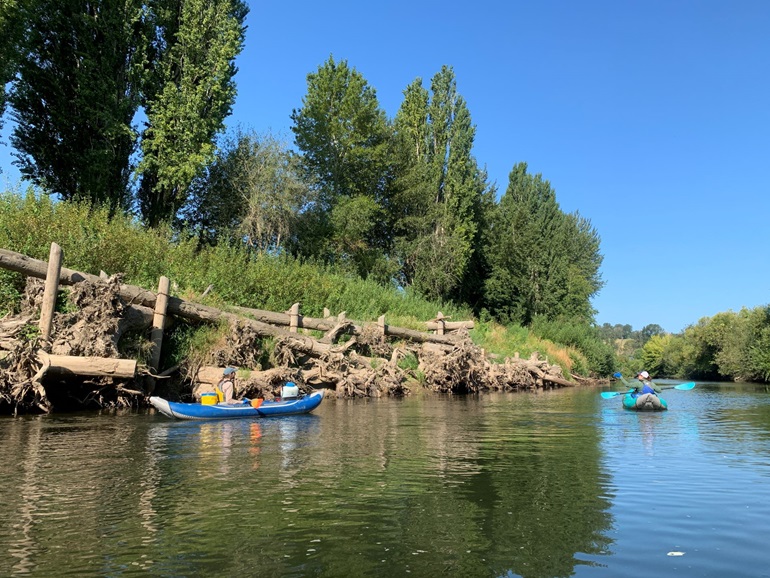Knotweed and rivers
King County’s Noxious Weed Program has a team dedicated to the control of noxious weeds, namely knotweed, along the shorelines and tributaries of four major rivers in the region.
When you get the eye for it, knotweed is easy to spot in large stands on open riverbanks. It's harder to see just how far it can spread into a floodplain forest in a short time and keep other plants from growing. Established knotweed impacts water quality, habitat health, and can damage property. The King County Noxious Weed Control Program works to remove knotweed and restore native plant communities along county rivers and floodplains. Knotweed is famously difficult to control and success is only possible with the persistent community effort of county residents, private landowners, and public agencies.

Who we are
The Riparian Team specializes in noxious weed control in river and stream ecosystems with a heavy focus on knotweed and garlic mustard. Four year-round staff and 4-5 seasonal field technicians make our ambitious projects possible. We are part of the Noxious Weed Control Program.
What we do
- We work on King County’s major river systems, starting at the headwaters and progressing downstream
- We engage and empower the community through education, technical assistance, and tool lending
- We use integrated pest management to guide our strategy for effective and ecologically responsible knotweed management
- We work with landowners and project partners to control weeds, replant native vegetation, and monitor long-term, watershed-scale projects
For more detailed information please see our Invasive Knotweed Best Management Practices document or give us a call.


Where we work
The Noxious Weed Control Program carries out cooperative, comprehensive knotweed control projects on four river systems:
- South Fork Skykomish and Tye Rivers
- Upper Snoqualmie River
- Lower Cedar River
- Green-Duwamish River
Project overview map

South Fork Skykomish and Tye Rivers, WRIA 7

Tucked away in the far northeast corner of King County, water from the Cascade crest forms the Tye River, which feeds into the South Fork Skykomish River, eventually destined for the Snohomish River. This mountain watershed is remote and beautiful, yet knotweed introduced to the area in the early 1900s flourished and worked its way into much of the otherwise healthy floodplain forests. We started with knotweed control work here in 2005 in cooperation with private landowners and the US Forest Service. By 2017, all 26 miles of mainstem and creeks with known knotweed were under active control. When the impact of knotweed is largely reduced, it will make control work downstream more feasible for Snohomish County.
The small communities of the Tye and South Fork Sky are passionate about the landscape and lend crucial support to the project. Other partners include the US Forest Service, Forterra, Sound Salmon Solutions, and the Town of Skykomish.
Upper Snoqualmie River, WRIA 7

The Noxious Weed Control Program began working to control knotweed on the upper forks of the Snoqualmie River in response to concerns from residents, landowners, and public agencies. In 2005, the program began working on the Middle Fork and its tributary Roaring Creek due to the high level of habitat value and relatively low levels of knotweed infestation. There was also an active cooperative weed management effort in the Middle Fork Valley. From here the project expanded to the much more heavily infested South Fork, including Boxley Creek and Clough Creek, and over time proceeded through the confluence and down to Snoqualmie Falls. This effort was inspired in large part by the strong interest and willingness to help by a group of homeowners on the river. Now, with the partnership of community members, the extensive infestations of the upper Snoqualmie are giving way to healthy floodplain forest.
This project could not happen without the support of the Snoqualmie Indian Tribe, Mountains to Sound Greenway Trust, City of North Bend, City of Snoqualmie, WA State Parks, US Forest Service, Snoqualmie Watershed Forum, Snohomish Basin (WRIA 7) Salmon Recovery Forum, King County Parks, and King County River and Floodplain Management.
Lower Cedar River, WRIA 8

In 2007, concerned landowners urged the Noxious Weed Control Program to begin controlling knotweed on the Cedar River. After a few years of treatment and realizing the complexity of this task, we sought additional project partners that would make a stronger, more successful project. In 2010, the Stewardship in Action (SiA) partnership was formed to control invasive knotweed, improve water quality, and restore riverine habitat on the Cedar River. The partnership is a collaborative effort between Forterra, Seattle Public Utilities, and the King County Noxious Weed Control Program. SiA offers support to landowners on the Cedar and its tributaries by removing invasive knotweed and offering free native plant installation.
Since the Cedar River Stewardship in Action partnership was formed in 2010:
- Total knotweed infestation size reduced by 90%
- 100,000+ native trees and shrubs planted
- 900+ acres surveyed annually for knotweed
- 2000+ people educated about knotweed
- 50+ landowners received free native plant gardens
Support and advocacy for this project is provided by the Cedar River Council and the Lake Washington/Cedar/Sammamish Watershed (WRIA 8) Salmon Recovery Council. Vital partners in this project also include City of Renton, King County Parks, and King County River and Floodplain Management.
Invasive knotweed is required for control on the Cedar River and its tributaries above the Renton City Limits.
Green-Duwamish River, WRIA 9

A partnership of public agencies led by the Noxious Weed Control Program started knotweed control in 2005 on the Green River from the headwaters down to Auburn. As the first large-scale knotweed control effort on a county river, it was a large undertaking and somewhat experimental. In the following years, the program honed field techniques and added project area downstream as knotweed area got smaller. The project currently includes mainstem river and creeks down to the Duwamish River in Tukwila, running through a wide variety of land uses, including mountain forest, deep gorge, wooded creek, agricultural fields, and urban residential and commercial use. Effective knotweed control has allowed replanting of native trees and shrubs crucial for wildlife habitat and water quality.
This work is successful because of our partnership with public and private agencies and landowners. Steadfast partners include King County Parks, King County Rivers and Floodplain Management, Washington State Parks and Department of Fish and Wildlife, the Green/Duwamish and Central Puget Sound Watershed (WRIA 9), Forterra, EarthCorps, and the Cities of Tukwila, Kent, Auburn, and Covington.
Invasive knotweed is required for control on the Green River and its tributaries above the Auburn City Limits.
Funding

Grant funding and other forms of support for these projects have come from many sources over the years including the following:
- King Conservation District
- King County Flood Control District
- King County Wastewater Treatment Division
- National Fish and Wildlife Foundation
- US Environmental Protection Agency
- US Fish and Wildlife Service
- Washington State Department of Agriculture
- Washington State Department of Ecology
- Washington State Department of Natural Resources
In addition, the noxious weed program, project partners, landowners, and volunteers have all provided significant in-kind contributions to each project.
Contact us for more information or to find out how to participate.

 Translate
Translate